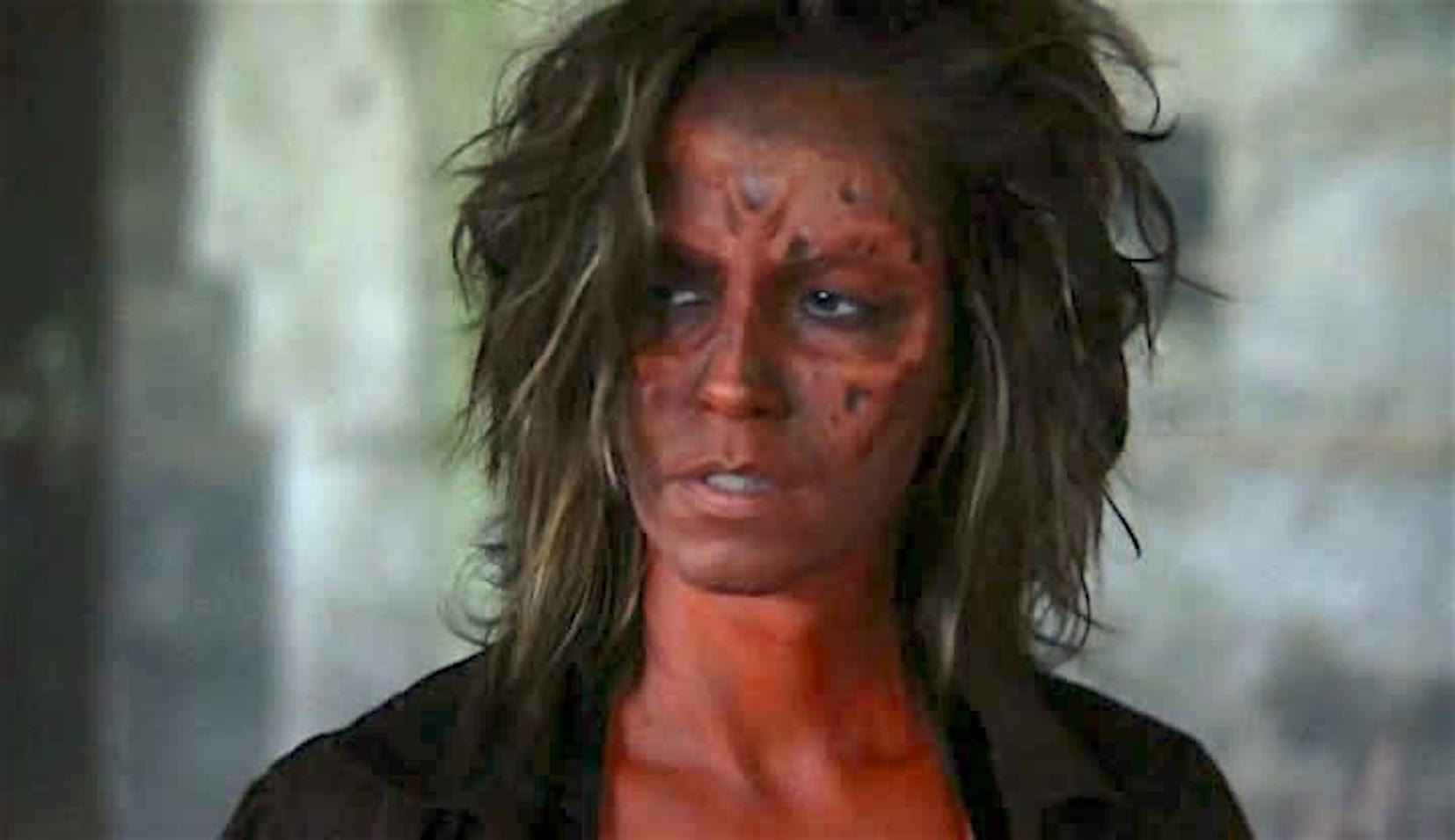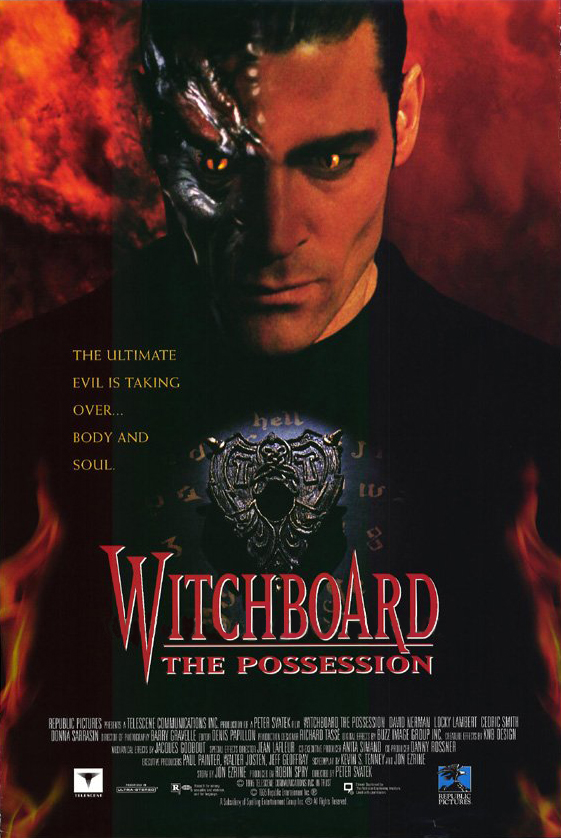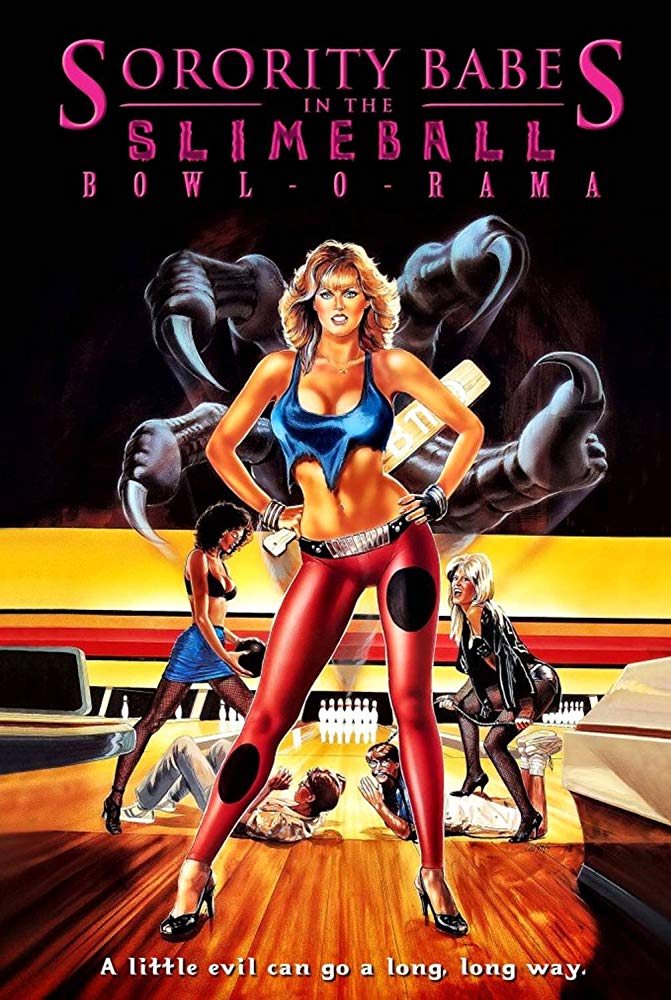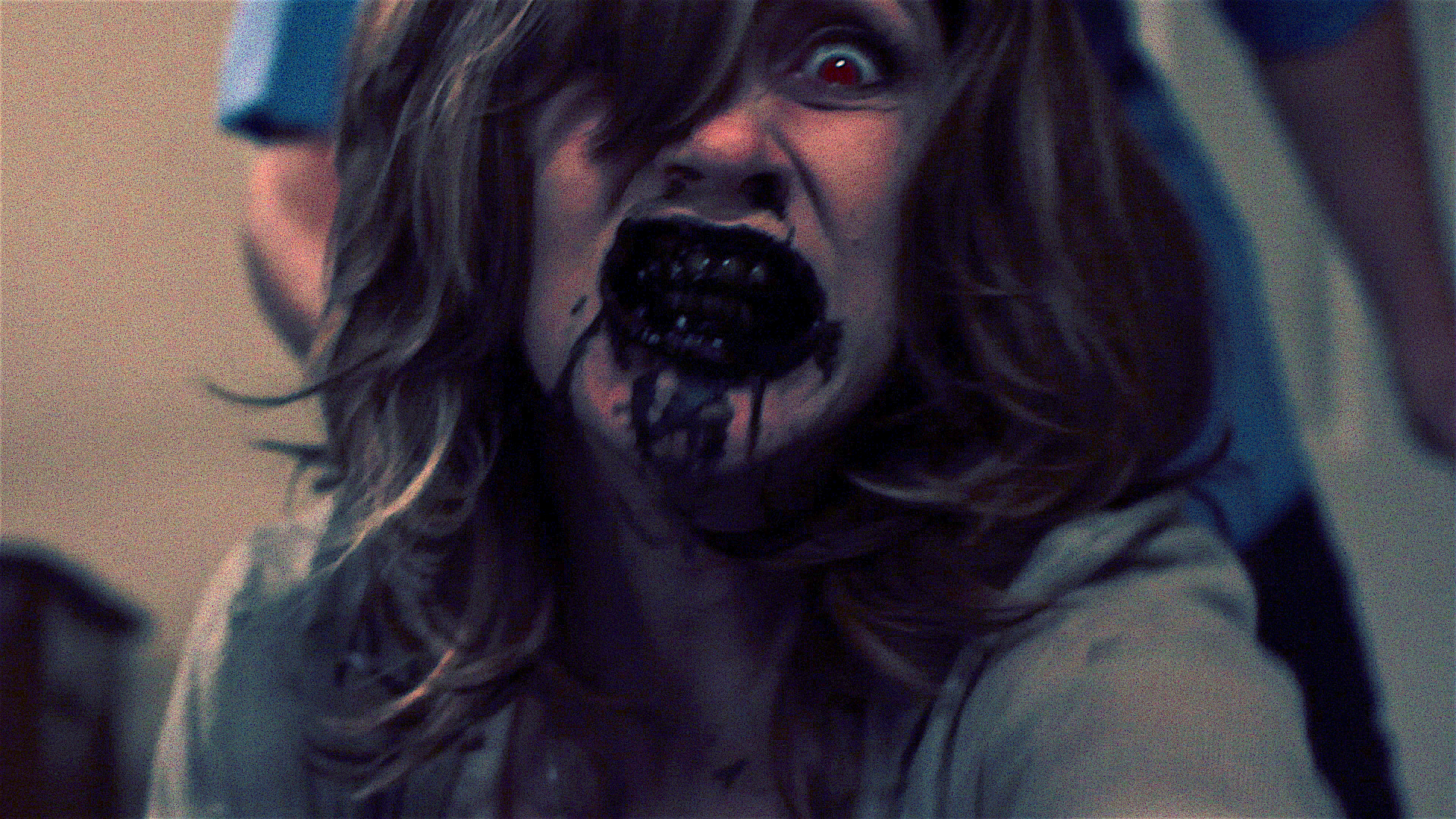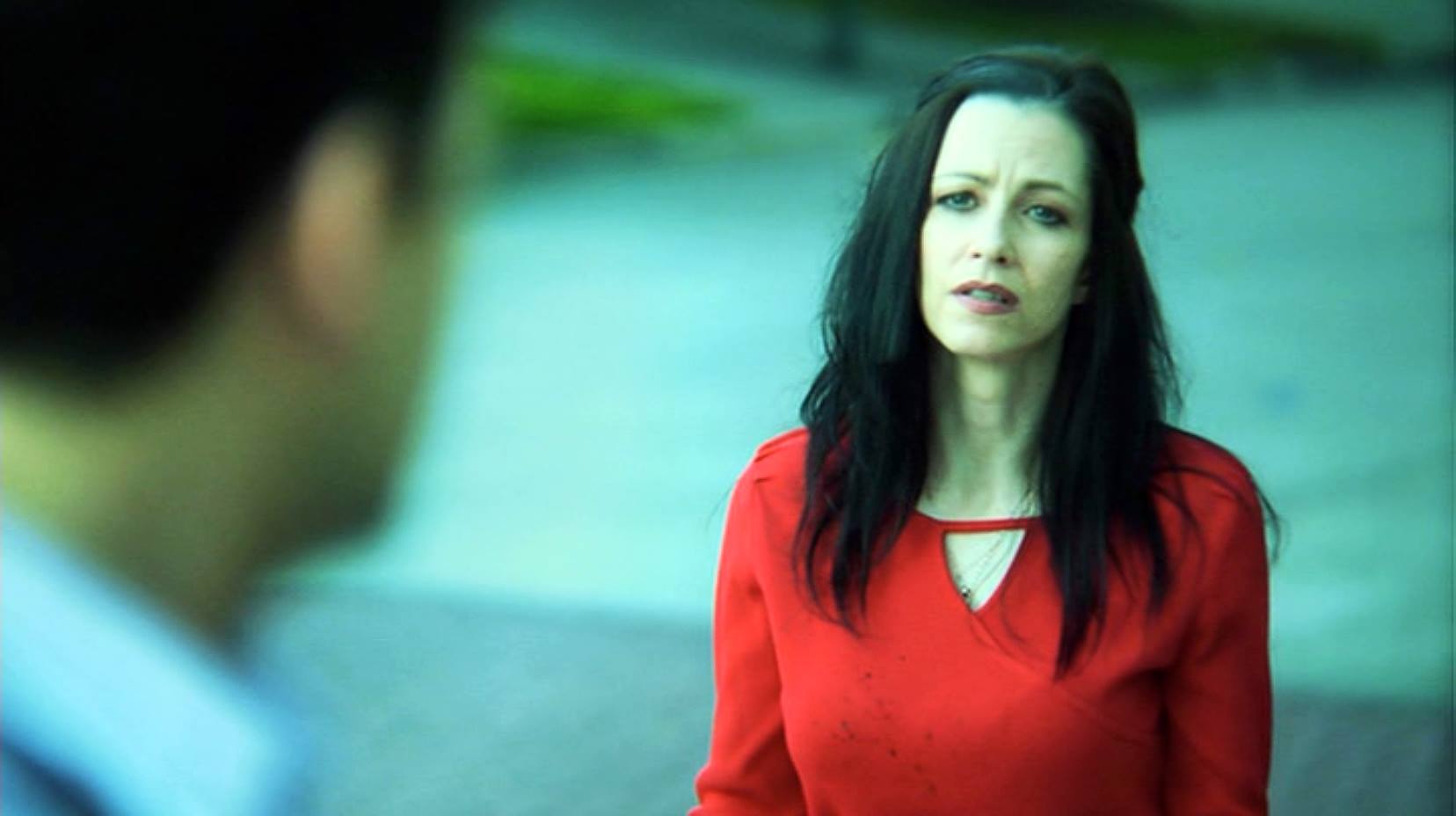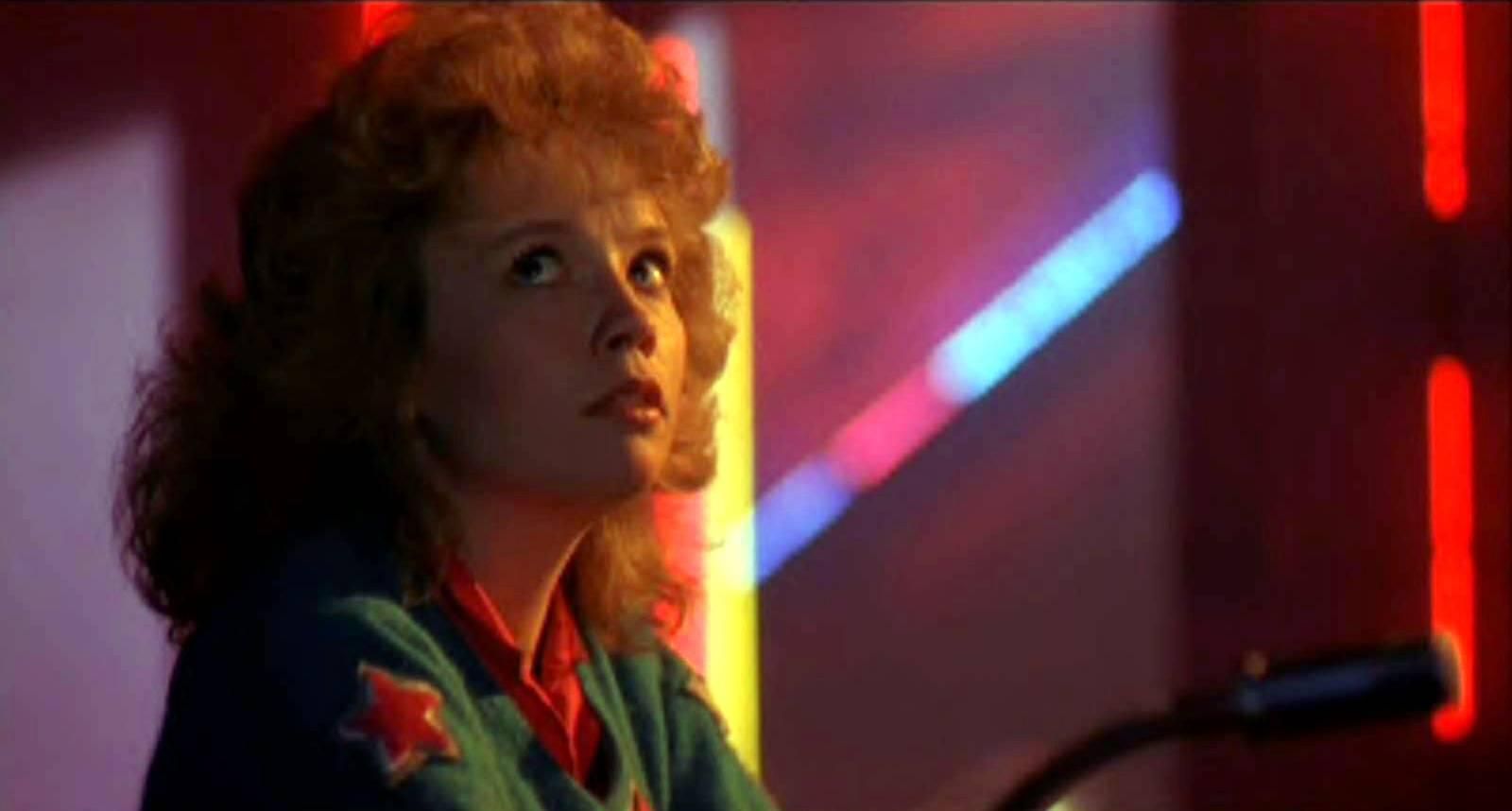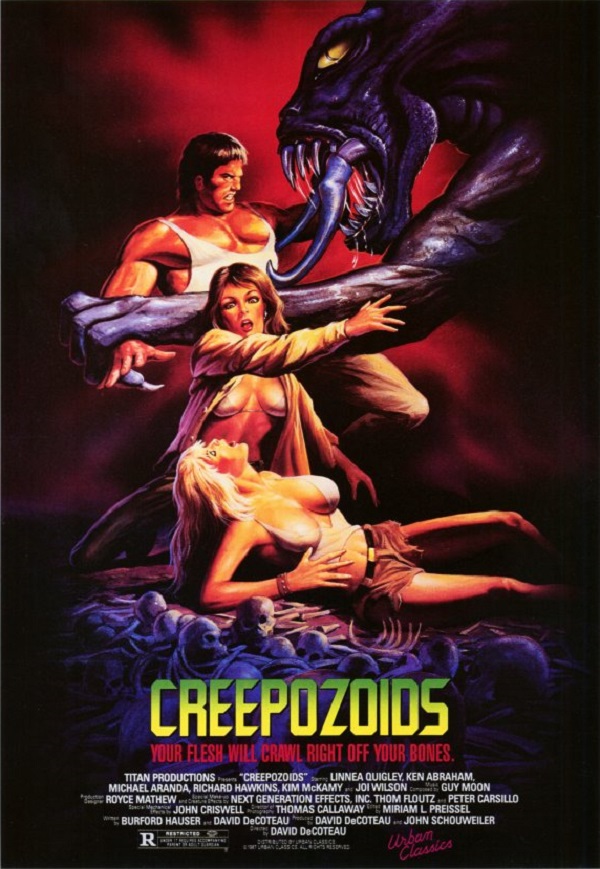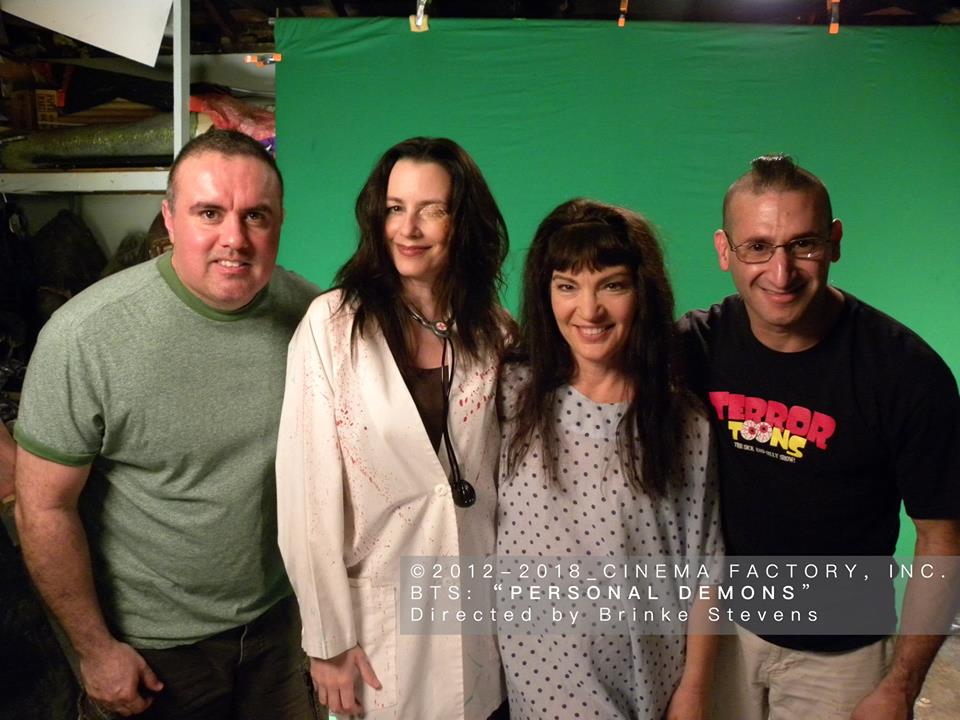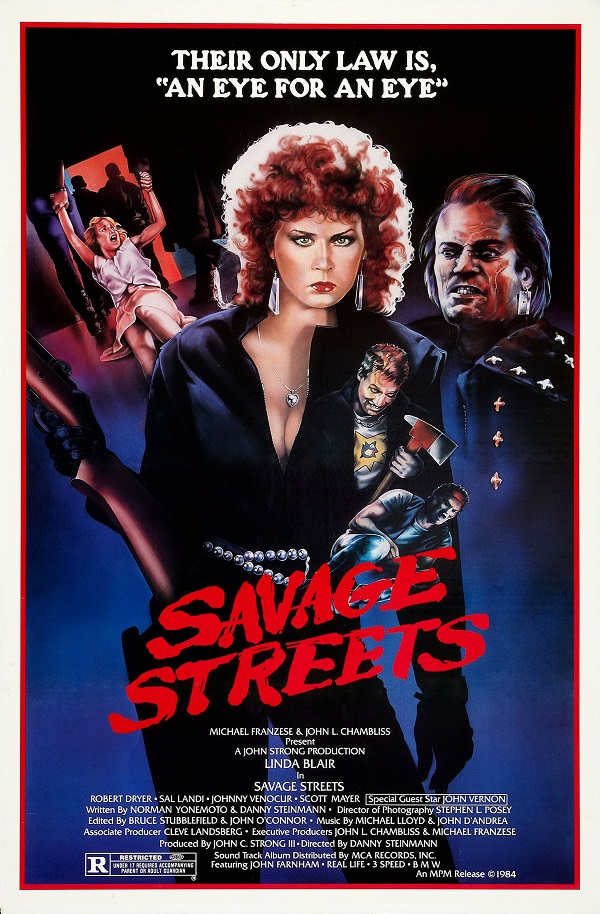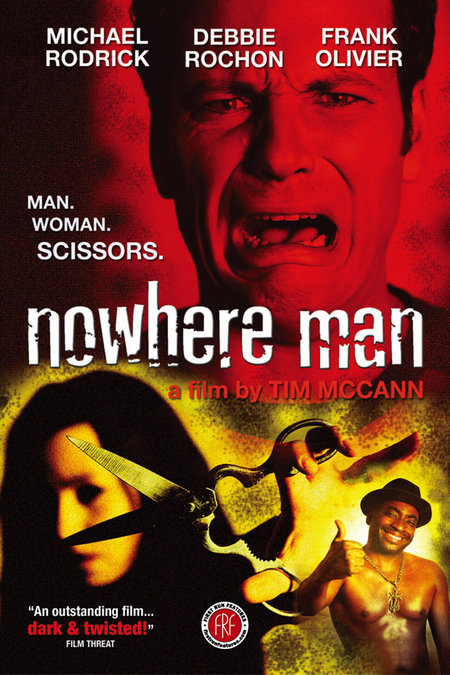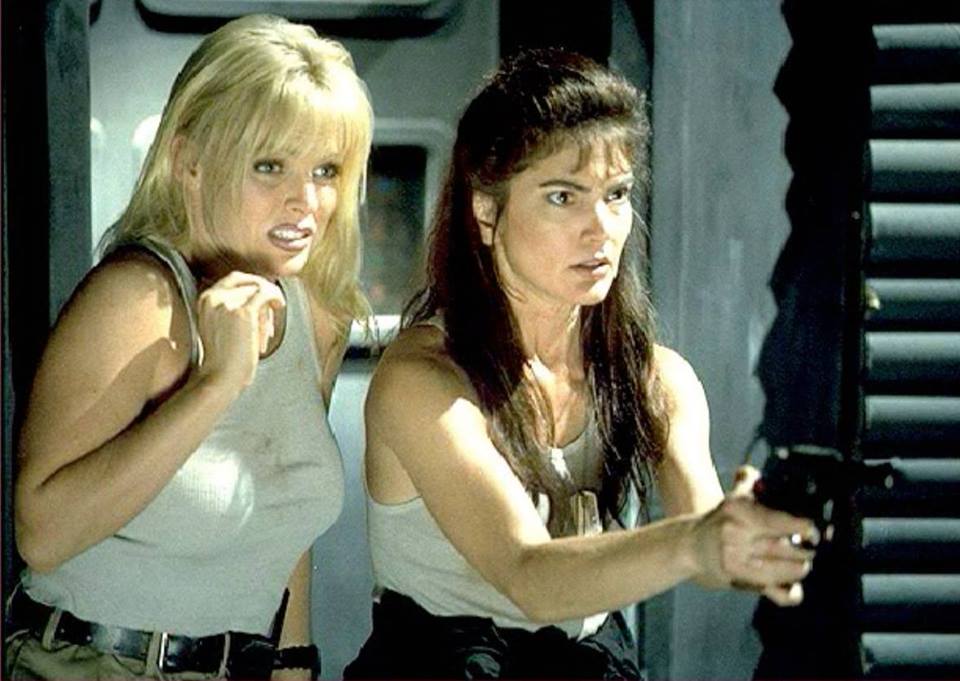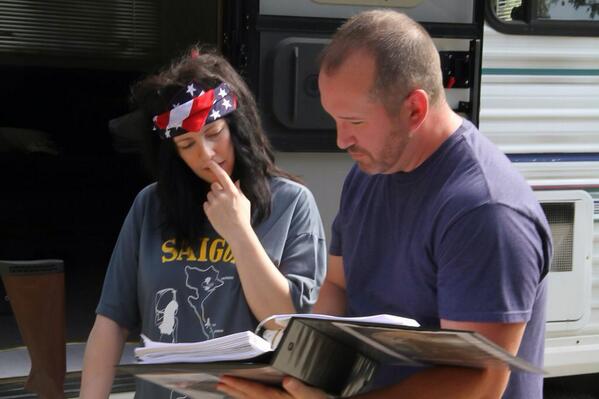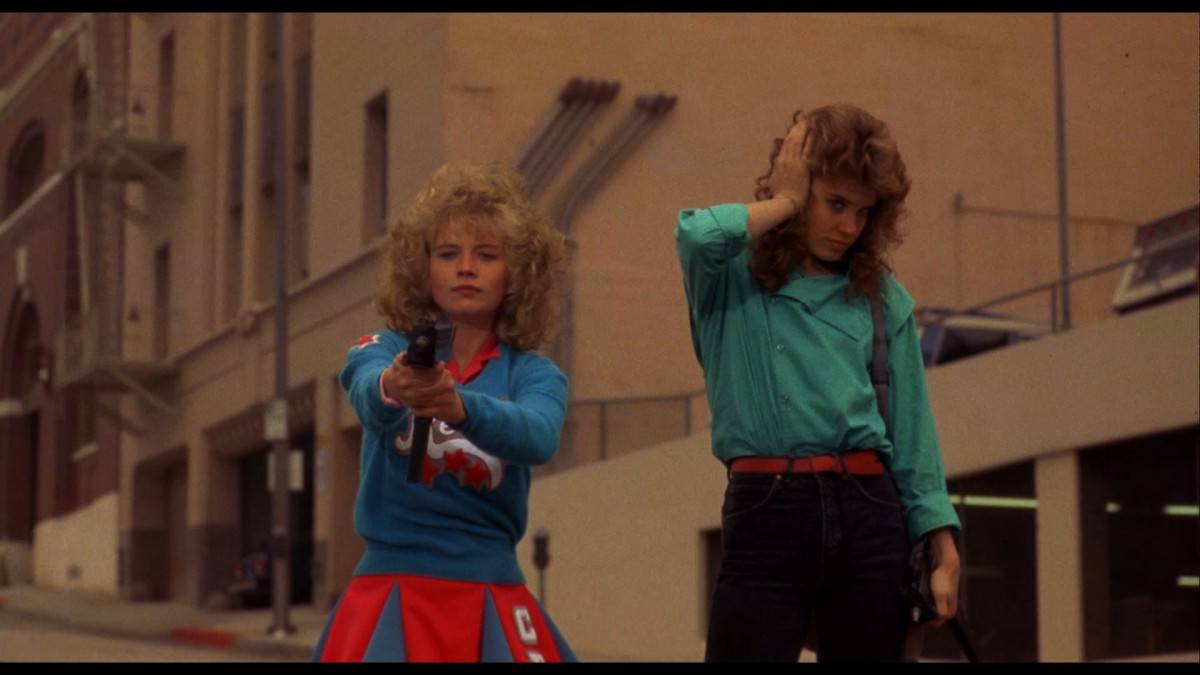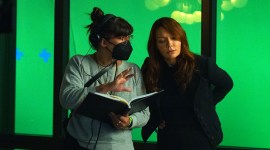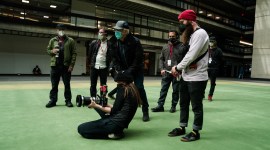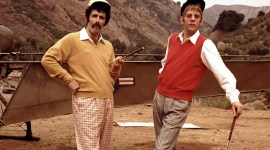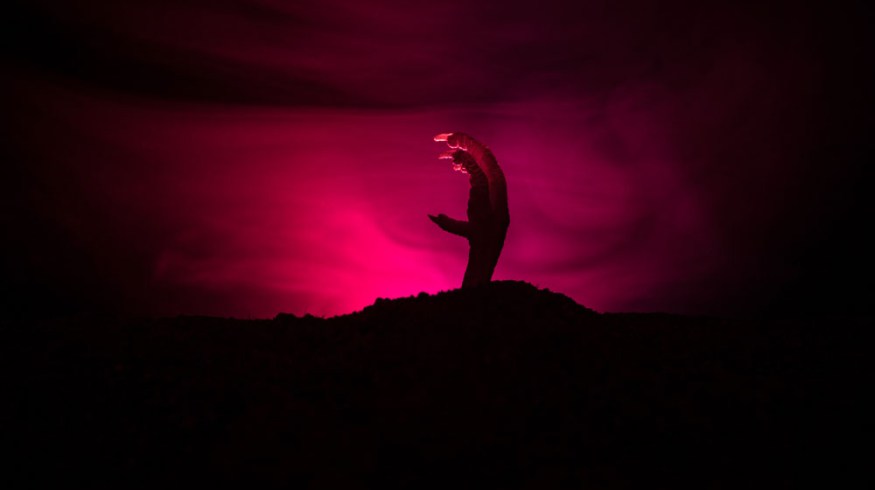
Round Table: Scream Queens on What Every Horror Director Needs to Know
For this interview, we sat down with a diverse group of horror actors to find out everything we didn’t know about horror film production.
Cover image via Ilkin Zeferli.
Horror is a genre that is terrific for new filmmakers, as it’s typically not star-driven, often needs limited locations, and comes with a huge audience.
It’s easy for the director to focus on the thrills and chills, but given that many of these films involve uncomfortable circumstances (stalking, assault, murder, torture, and sexual situations), it’s important to know the right way to keep your film set safe and professional, as well as how to respect your female talent.
We were fortunate to gather a diverse and prolific group of actors, who have all worn, by shriek or slash, the horror honey badge of honor. Linnea Quigley (Return of the Living Dead), Kelli Maroney (Chopping Mall), Elizabeth Lambert (Brain Dead), Brinke Stevens (The Slumber Party Massacre) and Debbie Rochon (Model Hunger) gave us all the gory details on what goes down and how it could be better.
PremiumBeat: Since you have all worked with many different directors, what can you say you appreciate or don’t appreciate about how sets are run, how you’re treated, or how safety concerns are handled?
Brinke Stevens: Safety must come first, and it’s astounding to me when young filmmakers forget about that. I shot a movie in rural Illinois that I was certain would kill me for real. We had several 20-hour shooting days in a row, with barely any food or sleep. I was a total wreck by the end of that awful week.
Debbie Rochon: Even if you are not shooting a union film, and even if you’re just shooting with friends, you must get some kind of insurance. It’s really not very expensive, and many different accidents can happen on a set. Lights fall, props malfunction — literally the unknown can and does occur.
I was on a set that I assumed had insurance. It was a non-union set. The props master switched out a fake machete for a real one because the fake one didn’t look good on camera. I wasn’t told it was real or “hot.” So seeing we had shot the scene a number of times already we just did another take right away. Well, a machete has no hitch to stop the hand from sliding from the handle to the blade and that’s exactly what happened. I severed my four fingers on my right hand almost completely off — except for the bone.
Kelli Maroney: I actually never thought of a set being run mostly by a director. There are so many other variables — the A.D. mostly. My work with the director is centered mainly on performance. I have never had a concern about safety on a set that wasn’t immediately addressed to my satisfaction. I am sensing here that might not be a typical answer.
Elizabeth Lambert: Probably the best experience I had was working on Witchboard III in Montreal, Canada. The whole thing was a dream job, pretty much from start to finish. I had never done a film in Canada before and didn’t realize how being over-the-top nice was one of the things Canadians Are famous for. The director Peter Svatek, was just venturing into horror from TV — he was so articulate and prepared and respectful. Needless to say, I was a bit nervous because [it] being an R-rated film, I knew that there would be a few nude scenes, which are never fun for me, and even though it wasn’t my first rodeo, I still dreaded them.
I think it’s always a little harder for the woman because usually it’s a male director with the male DP and most of the crew is male! You’re lucky if you have maybe one or two females around. They decided to shoot the love scenes the first week I guess in case anyone balked, they would be able to replace us without wasting any footage. Pretty much after I met my leading man, I would soon be hopping into bed with him. Woohoo! Of course, they made it a closed set, very few people — only the essentials that was necessary: either holding a light or a boom but no stragglers. And believe me, I always make sure there are no creepers hanging around just to watch! Cuz they do!
Linnea Quigley: David DeCoteau was worried about his actors and took good care of me. I got a little bruised up in Sorority Babes in the Slimeball Bowlarama only because the girl wasn’t trained. Then on the same movie, I told someone I knew while she was gone from location for a few days that this other girl was sleeping with him after her and they had a fight scene that night and the girl dislocated her knee. Good rule — no location romances.
When I first started, I was doing some short, and it was crazy. We were in a helicopter way up with doors open and the camera man was out the window strapped in, and they wanted to land between the mountains let me out, and I’d be running. Well the pilot almost hit a power line, yikes, and couldn’t land, so they decided to go to the private side of Burbank airport where important people come in. He wanted me to run nude by getting over the fence as he handed me an assault rifle. I said “Are you wanting me shot?” and luckily wouldn’t do it. Then I had to chase my money from him, but they have you do stunt stuff, and it’s not always fun.
PB: When you are working on films that have a very fast shooting schedule, how can the production set you up to succeed?
Kelli: Clear expectations of when I’ll be needed and which scenes are being shot and what, if anything has changed as the day progresses. There are so many variables with time, but strong communication as to what is going on really helps the actors.
Debbie: The most important elements are making sure you are prepared properly for a quick shoot. This means you know exactly what you want, you have all the shots worked out ahead of time, and you keep a sense of creative calm. If you have done all your homework, you shouldn’t be running around the set like a chicken with its head cut off. Seeing this just stresses out the cast and crew. If you are confident, the rest of us will be. Don’t leave the close-ups to the end. I know a lot of actors like to do them last because by then they really have a handle on what they want to do for the close-up, but if you are pushing through a tough schedule then the make-up (especially if you’re dealing with SFX!) is freshest earlier on. So just think of it like a glistening apple, you want to shoot the apple as flattering as possible for the scene and move out from there.
Practical SFX don’t last many hours, and the more you touch them up, the rougher the edges look, so you really want to get good close-ups of them right away. This stands for a long or short shooting schedule but especially for the filmmaker who can’t redo the scenes another day because the shots didn’t work. He or she can’t afford to do that. Remember everything comes from the top, and if you are taking all of these elements into consideration, all the departments will be appreciative of your efforts.
Like I said, pre-production can be where you spend as much time as you want, so really analyze what will be best for the movie, which in turn is best for everyone working on it. No one, paid or not, wants to be in a project that could have been so much better if the little things were thought of and taken care of.
Brinke: Sometimes actors have to run full-tilt and chase people, or else blindly flee for our lives. We often have vicious fight scenes and use a variety of deadly weapons.
Last week, I got this pre-production memo: “FYI: We don’t have a ‘fake’ meat hook for your death. We will work very carefully and safely with the real meat hook – camera tricks and creative editing. You will be safe. I have worked with this actor twice before, so we trust each other with real or fake tools. If you have concerns, please let me know.” At least they let me know in advance so I can be fully aware and take my own precautions on set.
Whenever I’m using a gun, I insist that the prop-man opens it up to convince me it’s unloaded. Just yesterday, in fact, they did this for me on a film set, since I was pointing a real gun (without bullets) at another actor.
PB: What relationships beyond the director are important to you? Costume designer? Effects? Craft services (do you need that coffee or protein bar to get you through a night shoot?)
Brinke: I often provide my own wardrobe and do my own makeup on movies these days. It’s a study in being self-sufficient. In the 1980s and ‘90s, when independent Hollywood studios made their own films, we actually had caterers, private trailers, and a full staff — but those days are long gone. I shop at thrift stores for my film wardrobe, since it will almost always get bloody and be totally ruined.
Last year, I did a project in Dayton, Ohio where the makeup artist was really only there for SFX work and completely unable to do glamor makeup. It was one of the rare times that I’d neglected to bring my own makeup kit (since I’d packed a light carry-on bag). So I tried to make due with whatever materials I could find on the set that day, but it was very difficult to do a decent job.
Kelli: As I mentioned, the A.D. is a crucial relationship. I’ve had some incredible assistant directors. They are organized, efficient, and have great senses of humor and are personable. Costume designer: yes, before actors ever get on set, meaning creating the role together rather than throwing some clothing at the actor and being irritated if the actor wants to try other things. It all goes better if we share our vision with each other. If there is a reason for that shirt, say so. If the art department or director wants hair or wardrobe a certain way, tell the performer. Hair and makeup — caring and fun people excel on set.
Almost all of us on set depend heavily on Crafty to keep us going with coffee, water, snacks, etc. And camera, sound, lighting — everyone affects the actor and can affect performance. As rules for all people on set: be professional, do your job, be ready, be kind, be friendly, be considerate, be compassionate and forgiving, and have fun! These qualities make all the difference in production.
Debbie: Coffee will always be my personal number one important relationship! I call it my acting juice. The costume and makeup departments are vital. Again, if you have these departments on your set, and the actor isn’t doing that for themselves, it’s a collaborative effort to put the character together. Same can be said for lighting and camera work. If you give a knock-out performance but it wasn’t captured properly, then it has failed. If you are lit incorrectly, then it’s a failure. The costume and makeup departments for actors are not just there for the convenience of the actor.
I made a movie where I was playing a barfly/bad mother to the lead character. I had worked on the part for about a month before I arrived in Texas to shoot. The hair and makeup artist did the worst job and didn’t listen to what I was explaining to her, and I ended up looking like a frumpy librarian drinking at a bar. She also did this to a number of the other actresses too, I later found out. So having a team that’s on the same page to make the creation come to life is imperative.
Linnea: I like to play pranks depending on the people or set. Well, we were doing Creepozoids, and my love interest was getting up at five in the morning to work out and watching what he ate. We did this shower scene, and they had rigged a water jug above us. We were on boxes, trying not to fall off, and they were blowing smoke, and we got it done. He had been so nervous. Well, two days later, he is eating a lot and no gym, so I said to him “Damn, I cant believe we have to reshoot the shower scene again.” He looked horrified. A bit later, I peek around the corner to see him doing push-ups and all to get into shape since he had slacked off.
PB: Have you ever worked with a female director?
Brinke: The only female director I ever worked with was Amy Jones on my very first film, The Slumber Party Massacre. Since the script was written by famed author Rita Mae Brown, it was quickly labeled a “feminist horror film.” Nonetheless, I think it was just as gory — though perhaps with more humor — than any male slasher film of that era
Debbie: I have worked with only a couple of female directors. The most recent was Brinke Stevens who was exceptional. Why? Because she had everything prepared perfectly. She has acted in the business for a long time and knew how to speak to an actor. She was calm, focused, and knew exactly what she wanted. When we were finished, it just felt like a breeze. She had the experience and knowledge of working in the industry long enough to know all of the large and small details that make a shoot run smooth.
My first female director was Roberta Findlay in 1989 and she was a riot. A very eccentric NY personality. She would be laughing with everyone one minute then yelling the next. But she came out of the ’60s, ’70s, and ’80s film scene where you had better be tough, especially as a woman, or your crew will not move when you need them to move.
The difference I have experienced is minimal really; I have had very kind male directors and yelling, frantic male directors. I like both for different reasons. Male directors can fall into traps that include falling for one of the actresses, which messes up the film because the other actresses have to push through all of that BS to just get their roles across. That doesn’t always happen, but it happens more than you would think.
PB: I assume that violent scenes are heavily choreographed, but have you ever felt uncomfortable during filming? What made it that way? Can you share a difficult scene that was made better by either the director or crew or talent you were working with, and what was it that made it better?
Linnea: Well, now some scenes aren’t choreographed at all. I had a scene in Savage Streets where I’m being thrown around, and I felt one of their pins go in the skin, and I was so scared he was going to throw me before I could get my arm out of harm’s way. Plus they didn’t break character, so when they would tear off my clothes, the fabric that was supposed to rip didn’t and ripped into my shoulder.
Debbie: Yes I had to do a scene in a movie called Nowhere Man that was extremely intense. I am with my fiancé who found out something bad about my character and when he comes home drunk, he wants to have sex, and we start to, but then it becomes rape. Very nuanced and difficult to physically choreograph and emotionally choreograph. In that case, it was such a difficult scene. The actor, whom I trusted 100%, really didn’t want to do the scene when it was time to shoot. But we had to for the story to work. So he had to have a beer (he never drank otherwise during the shoot) and the director told us what he wanted — framing wise — and boom. Action. That’s it . . . we had to just jump in and go through it and figure it out. Luckily we did. That certainly was one of the many times I was thrilled to be with a great actor whom I could trust.
Too often in low budget movies, when there is a scene that requires a fight of some sort, the director thinks it can just be worked out on the spot, or they come up with something that is not very compelling or believable, and you try to adjust it so it works. If there had been a proper choreographer then it would have looked so much better.
Also learning choreography on set is hard enough, so I would highly suggest the director and instructor beak it down by the shot so the actors can go full-out with no worries that they will forget one of the steps if it’s a long battle. In a perfect world, this is something you would have time to practice. Sometimes you do and sometimes you don’t.
Elizabeth: Some of the most common-sense gestures are the most appreciated — like once when filming a very violent scene in the dead of winter in freezing [. . .] Palmdale (don’t ask) with lots of sticky, gooey blood-lying on the stone floor, after my coverage was done, someone had the wonderful idea to a put a pad underneath me so i wasn’t lying on the cold hard surface forever. I also appreciate when make up/hair/FX artists help take all the crap out of your hair after the shoot. I even had one angel, who after removing all the junk, would give me a much needed, stress-relieving head massage . . . now that’s the ideal makeup person you won’t find every day!
Brinke: A couple months ago, I worked on Super Special in Huntsville, AL. The script called for me to have a fight-to-the-death scene with the killer, who would then pick me up and throw me off a second-floor balcony. (This would be faked with a dummy.) When we arrived at the location, the director realized that the balcony railing was poorly attached, very wobbly, and likely to break if pressed against too hard in a fight scene. To his credit, he re-wrote the scene so that my adversary merely strangles me to death instead, and I sink to the floor at his feet. Perhaps not as dramatic a demise, but so much safer!
I remember a scene in November Son, where I had to wade into a scummy swamp to tussle with a not-so-dead corpse. It took place late at night, and I was terrified to enter the water for fear of leeches or whatever. I insisted on wearing my shoes into the swamp, for one thing, so as not to step on any sharp debris. Seeing my hesitation, the director Jason Paul Collum went into the water before me and stayed there during the whole scene. I pulled it off despite my trepidations! Later, after I went inside our location-house to shower off, I shampooed thick green slime out of my hair and off my body. I started laughing hysterically, thinking about how we’ll do such horrible things for movies that we would never do in real life.
PB: What about sex scenes? Most of the time, you hear that it’s pretty unsexy on set. Very technical, and you’ve got a huge crew around. How important is a closed set for you on those days? How important is it that the director and crew understand and take care to make it as professional as possible (i.e. wardrobe ready with a robe in filming breaks, only having the people absolutely needed on set, trusting the actors you are working with and feeling safe in their presence).
Brinke: Early in my career, nudity was simply the rule . . . what was expected of us. We just went along with it because we wanted to work. (But later on, I had to cut those scenes out before showing the videos to my parents!) I’ve never been shy about nudity. Good thing, too — my willingness to undress landed me a lot of good roles and helped to get me better noticed by fans. However, I was never comfortable doing explicit “love scenes” with a guy, so I tended to turn down those kind of parts. In almost every case, the directors have been very good about asking non-essential personnel to leave the set and we were treated respectfully. But then, there you are totally naked up on the big screen being watched by hundreds of people! I’m quite relieved that I’ve reached such an age where I’m no longer asked to do this and it’s left up to the younger starlets
Linnea: It’s so immature, but producers, grown men, would come on the nude day and I always shooed them away. I didn’t know when I started that I could ask to clear the set if I was doing a nude scene, but now I do. It’s not sexy. You have to keep yourself in light, and it’s awkward.
Debbie: Every actor is different. I have witnessed female and male actors walk around a set naked. I imagine it’s because they are that comfortable or they are trying to get comfortable. I was never one of these actors. Nudity is in almost all of my favorite TV shows or movies — it’s a very common thing. I think the best balance is to close the set but not make a big deal out of it at the same time. I have been in nude scenes where everyone not needed was whisked away but they were banished in such a way that when I emerged from the set, they all turned around and looked at me strangely — no, that was not my imagination. If it’s handled professionally and not as though the set is suddenly becoming an X-rated set, I think that balance is best. For me, the “no big deal” vibe is really cool. I don’t do nude scenes anymore, but when I did, I always appreciated the robe between takes and a “thank you” after. I have no idea why, but a little acknowledgement of the discomfort from the director was nice.
PB: What would you like directors to know about working with female talent that would yield better results?
Brinke: Running in high heels is very difficult! For It Came From Trafalgar, I had to race across a field in high-heeled boots. Of course, one of my heels got stuck in the dirt, and I plummeted down face-first. Also, I’m frequently asked to scream bloody murder in my films. I refuse to do it anymore, because I now have a sideline career of voiceover work and recording audio books, so I have to protect my assets.
Debbie: If you are new, don’t be afraid to talk to your female cast. Some directors are a little nervous about that, and it’s okay. Just realize actors thrive on feedback because they can’t “see” what they’re doing. The obvious advice would be don’t engage in sexual tension with your female cast — not only does it create a bad working dynamic with that actress, but it also alienates the other actresses, and trust me, the crew will lose a lot of respect for you. Even if they would never admit to it. The movie is the “thing.” It must be treated as the artistic project that it is.
It’s bigger than a flirtation or even if you find yourself in a “teacher’s pet” situation. That always alienates the other cast members. So best not to go there. Also important — have the male actor know how to act a love scene. This is cinema, not real life, and an actress feels very horrified if they have to be the one to say stop. It’s fine if they do because the director might not have caught it, but if you see that the actor is taking advantage in a sex scene by groping places or things that aren’t even in the frame then stop the scene. This is all about trust, respect, and with any luck, you’ll have your cast and crew walk away wanting to work with you again.
PB: What’s it like working with a seasoned director vs. someone who is new to the process? Any advice you’d have for filmmakers who are about to make their first horror/action or exploitation film?
Debbie: A seasoned director can be great because they have a way of setting the pace with confidence and he or she has the respect of the team because of it. I don’t mean approaching it like paint-by-numbers but in a strategic way that lays down structure. I love working with first-time directors too. They often have ideas that “pro” directors don’t because they’re thinking out of the box. They can also be more excited about being there, and that’s very contagious. But when working with first-time directors has been a problem it’s because they didn’t have the basics down. They didn’t have a shooting schedule so that everybody knew the night before what they were facing. I personally don’t need the daily sides, just a basic shooting schedule. This also goes for their shot list for the D.P. All of these things come with experience, and some new directors are more together than others. At the end of the day though, I would rather be collaborating with an artistic creative director who may not have all of his or her ducks in a row perfectly than the dry, unimaginative product-only concerned veteran.
Elizabeth: My main advice to new directors is to take an acting class — learn about the process. So many of them know their way around a camera and technical things but know absolutely nothing about how to direct an actor.
Linnea: I worked once with a director that we started the day off with me coming in a door, so I’m waiting to hear direction and I’m hearing “Go.” He didn’t even know the terminology. Also, new directors shoot too many master shots.
PB: You’ve all had incredible careers, and longevity in this business is not easy! From your perspective, what has been lost and what has been gained in the last decade or so in terms of women in the industry?
Debbie: Women have really gained a lot. While I could pine over things like “I used to be able to keep my entire wardrobe” and meaningless things like that, I would rather highlight something like the great female viewership that has massively grown — and it’s wonderful. There are more women working on both sides of the camera now. There are more projects that either have no exploitation or it’s equally distributed between the sexes! Writers, authors, directors. I think every aspect of this industry has come light-years since the ’80s. I love the ’80s films, but indeed, if you were female, you had to take whatever role was available if you wanted to work. Now, there’s so many projects on so many budget levels, you would be hard pressed not to find a job
A paying job is another story! I don’t work for free, but back when I started, I did. I nabbed every NYU thesis film I could so I could practice my craft. The difficulty now is distribution for indie films. Where there was a huge void that had to be filled by new cable channels and rental video stores or chains, now all that is gone, and you have possible streaming outlets for your movie like Amazon, Netflix, and a possible shot at Walmart. Very hard to make your money back. If you’re lucky. and it becomes a slow-but-steady sell, you can break even around the 10-year mark. That’s if it didn’t become a breakout success like The Blair Witch Project.
Linnea: It’s changed. Wow, it’s digital instead of film, which I miss, and things, because of that , move faster. It’s great women are producing and directing now and are getting powerful, and the talent . . . well the new ones aren’t as prepared as the older ones. A lot of stuff is CGI, done on a green screen, you aren’t even sure what’s real. They can do so much it boggles my mind, so everyone’s job seems to be less, and with digital you can do a lot of takes. We had to get it right the first time using film.
PB: Any final thoughts?
Debbie: Another great thing to keep in mind if you are shooting a small-budget film is to remember where you are shooting! I was in Arkansas shooting a voodoo-themed movie a few years back, and the local Baptist Church got wind of it. They took it to the town council immediately and had all of our locations taken away from us! The church threatened all the local establishments that we were going to shoot in that they would “ruin” them. In reality, the church lost the location fee for the owners. We still shot the movie in different locations, but it really threw a curve ball into the shoot as it happened two days in. If you’re going to make a witchy movie in the bible belt, make sure you either go to town hall and tell them in advance or change the title of your film to Flowers Are Beautiful or something. Each area will have its own prejudices — so be aware!
Looking for more industry interviews? Check these out:
- Interview: Behind the Scenes with Producer Bonnie Curtis
- Interview: Keeping Score with Film and Television Composer Nathan Barr
- Interview: The Film Collaborative on Filmmaking Rights and Distribution
- Interview: The Editor of “This is America” on Building the Iconic Video
- Set Your Film Right: On Location with Robert Foulkes


